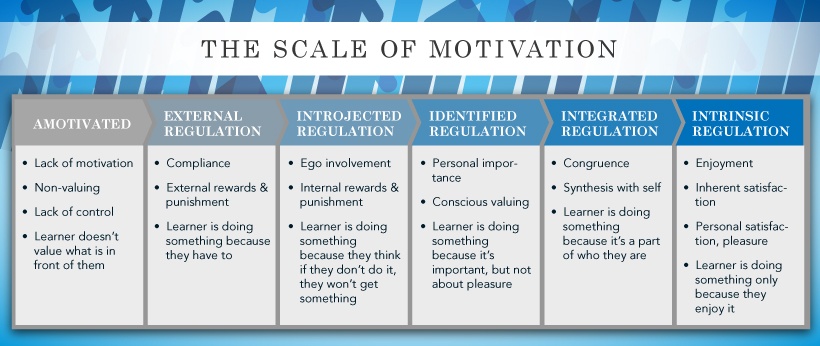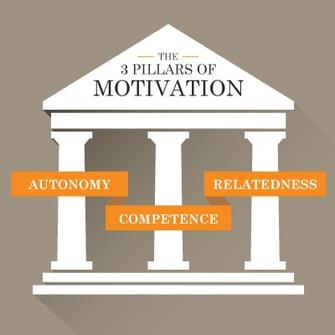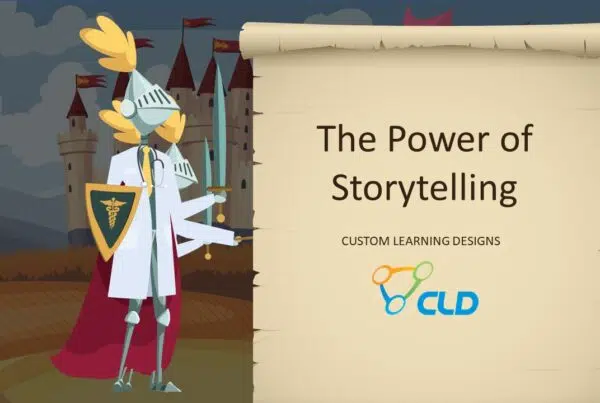
The webinar started off with this quote, which really hit home for me. How often do we expect talented people to just automatically be successful, solely based on their knowledge, experience, or skill set? As trainers, what role do we play in helping to motivate our learners to apply their talents to reach their potential and achieve success in their roles?
Kristianna presented us with the scale of motivation, which is graphically represented above. My mind automatically started thinking about all the different tasks in my daily routine and where they fall on this spectrum. Working with eLearning, it’s unreasonable to expect learners to find complete intrinsic value in completing sales training modules (although that would be amazing), but we can still help our learners to move along this motivation continuum and encourage growth along the way.
Self-Determination Theory
At the heart of motivation is Self-Determination Theory (SDT). The SDT model blends our innate psychological needs with our natural desire to continuously grow. With proper tools for learners, the fact is that while we can’t force someone to be motivated, we can, as trainers, create an environment that encourages personal growth. Self-Determination Theory teaches us that there are 3 basic needs for growth, in other words, what helps us move from Point A to Point B:
- Autonomy
- Competence
- Relatedness
1. Autonomy
Autonomy provides us with choice, self-direction, independence, the ability to be heard, and freedom from external control. (Awesome, right?) While our industry may be highly regulated and structured, we can still design training that supports autonomy around this regulation. A balance of autonomy generates the most effective learning environment.
Some ideas for designing training with autonomy in mind include:
- Choose your own adventure
- Articulate Storyline branching: feels customized with elements of individual control
- Free play navigation
- Learners can explore environments
- By not locking down modules, learners can jump ahead and go back
- Optional additional learning
- Need to know vs. want to know
- Provides an element of control to choose what additional topics a learner might want to know more about
- Ability to re-access modules
- Learners are able to control their own learning in the long-run
- “Smart” pre-test
- Does the learner truly need to take this specific training?
- Can learners test out if they qualify?
- Eliminates redundancy
- Surveys
- Individuals have a voice, let your learners know that you want to listen to it
- Letting learners have control in their learning leads to autonomy
2. Competence
In order to encourage learners to do something successfully or efficiently, we must design our training to the appropriate level of challenge. There needs to be a self-efficacy link, or simply mind over matter. Think about it.. if you didn’t believe that you had the ability to influence your results and eventually do something well, would you be motivated to keep practicing?? Once a learner gains competency, they will believe that they can truly apply what they’ve learned to real-world scenarios and on-the-job settings. Some ideas for designing training elements that support competence include:
- Scaffolding
- Create learning in “digestible chunks”
- Gradually form steps, building up levels of knowledge and skill to reach mastery
- Feedback
- Helps learners to understand what they need to do to improve and gain competence and therefore be successful in the future
- Retakes
- Not just for tests
- Repetitive experience and practice enhances retention
- Appropriate challenges
- Don’t want them to be too easy or too hard
- Allows learners to see where they started and where we want them to get to
- Watch, try, do
- See, try, apply
- Simulators
- Guided practice
- Independent application
- Videos
- Offer a vicarious experience
- Learners can relate: “If they can do it, I can do it.”
- Post-learning on-the-job training
- Allows learners to apply knowledge to real work situations
- Virtual reality
- Allows learners to practice until they get it
- Learners will be more likely to apply their newly acquired skills and knowledge on the job
- Game-based learning
- Allows learners to perform a skill until they do it well
- Supports confidence on the job
3. Relatedness
The concept of relatedness is based on feelings of connectedness and belonging. Individuals inherently desire to interact and be connected in a way that allows us to experience caring for ourselves and others. In order to motivate our learners, it’s important that we encourage partnership and provide support along the way.
Some ideas of how to integrate relatedness into eLearning include:
- Relate learning to the job
- Remember to “walk in your learners’ shoes”
- Use the word “we”
- Avatars
- Training is more personalized
- Learners can see that the training is meant for them/related to them
- Variables (data is remembered/stored and then content is displayed based on conditions)
- Delivers personalization for learning
- Provide personal help and resources
- Add to the learner’s experience to show you care about their growth
- Social Media
- Brings like-minded people together, form a common bond
- Motivates individuals to be a part of a larger experience
- Branching by job function
- Specific to an individual’s job and needs
The 3 pillars of motivation (autonomy, competence, and relatedness), when combined, help to establish the most effective and beneficial learning environment. The result is increased motivation and engagement, even when the material may seem dry or relatively uninteresting. Learners are able to more clearly see the value of the work they are doing and the tasks they are completing. This encourages them to develop their own talents and enjoy continued growth and development.
Specific results that trainers often see when a commitment to SDT is made and incorporated into learning design include:
- Better performance: cyclical self-efficacy
- Engagement: more attention, enhanced learning and morale
- Pursuit/retention: throughput, completion
- Transfer training to the job: specific to autonomy
- Employee retention: lower turnover, less money spent on recruiting
- Better performance: higher productivity
- Increased employee satisfaction
In what ways do you inspire motivation in your training? Do you have any other suggestions to add to the list? Let us know in the comments!
Want to learn more about Self-Determination Theory? Check out http://www.selfdeterminationtheory.org/







